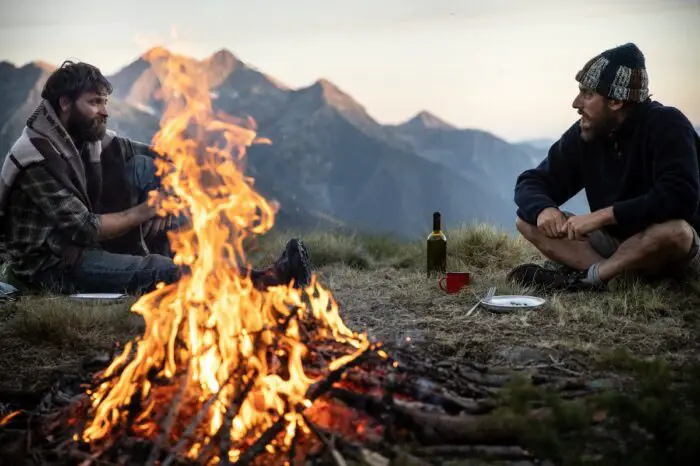Note: this article contains spoilers for both the novel and the film adapting The Eight Mountains, currently in theaters and due for release in the debut set of Janus Contemporaries this fall. For Film Obsessive’s spoiler-free review of The Eight Mountains from April, click here.
It’s been more than a month since I first watched and reviewed The Eight Mountains, the 2022 Cannes Jury Prize Winner directed and adapted by Felix van Groeningen and Charlotte Vandermeersch from the Italian novella of the same name by Paolo Cognetti (Le otto montagne). In the weeks since, I can’t quite stop reflecting on its themes and techniques. All too rare is the film that can adapt a source novel so faithfully—with little, really, changed—and yet stand, brilliantly, majestically even, on its own.
The Eight Mountains is based on the contrast between two men who meet, first, as young boys in the Italian Alps, then separate to go their own ways, only to meet there once again and work together as adults in what becomes a complex, rewarding, and at times frustrating friendship of uncommon closeness and contrast. One, Bruno (Alessandro Borghi), is of the mountains—raised there, inextricably bound to them, forever, it seems, a part of them. The other, Pietro (Luca Marinelli), is a visitor—intrigued by those same mountains but never at home in them, a wayfarer by nature who can never stay long in one place. Together and apart, they represent to me something intrinsic to the very nature of adaptation itself: both staying true to a source and venturing into new terrain.
That very willingness to forge a new path, even while remaining true to a source, is to my thinking what makes the film adaptation of The Eight Mountains so effective. I am not one to tout simple fidelity as a virtue. Any film might be more or less faithful to its source and might be (more or less) effective as a film. Even when adapting a source, a film is above all a film and must work in its own idiom rather than hew strictly to what came before it. And in general, my own tastes tend to run towards those adaptations that more radically rework their sources in one way or another: In a Lonely Place, Apocalypse Now, Short Cuts, Little Women.
In adapting Cognetti’s slim, if wide-ranging, novel, van Groeningen and Vandermeersch clearly approach the source with a degree of reverence. Place and character names major and minor, basic chronology, and character traits are all transfer directly from source to adaptation, though there is, I assume, little reason one might be tempted to alter such details from a novel so rigorously grounded, as Cognetti’s is, in a particular place and whose settings represent key themes so directly. The fact that the filmmakers enlisted Cognetti as an artistic consultant and collaborator on dialogue suggest that they will take few liberties with the source novel’s basic outline.
Cognetti’s novel takes place over four decades of the protagonists’ lives, yet it is, like a good film script, adept in its eliding long stretches of time when Bruno and Pietro are not part of each other’s lives and compressing those when Pietro—the book’s and the film’s narrator—is living his nomadic life far away from Bruno and his mountain home. The novel presents the two boys’ first meeting and childhood friendship in detail, as it does their summer building the mountain home left to Pietro by his father, and their subsequent time together there; Pietro’s adventures in Nepal are compressed as secondary interludes, counterbalances to the scenes on the mountain. It’s a narrative structure, oscillating between scenes of the two men on the mountain and those of Pietro’s journeys, that translates well to film, which since the days of D. W. Griffith cross-cuts intentionally between locations.
Cognett’s novel is narrated in the first-person past tense by Pietro, who in his adult life becomes a writer and documentary filmmaker, a man of the arts with a keen eye for observation. It’s a common, if restrictive approach to literary narrative, one that delimits what can be told to what the narrator-character can directly observe or later learn. And while even an intelligent, learned narrator like Cognetti’s Pietro can remark knowingly about another character like Bruno, he can never know, like a more omniscient third-person narrator could, what a Bruno might actually think or feel. In fact, that Pietro knows so little of Bruno’s companionship with Giovanni (Filippo Timi), Pietro’s father, developed over years of treks together in the mountains, demonstrates how slim his knowledge is of either man’s true character.

It should be said that there really is no direct equivalent in film to the kind of first-person retrospective narration common to literary narrative generally and The Eight Mountains source novel specifically. Since its inception film has largely adopted the proscenium perspective, setting events in front of a viewer rather than adopting a character’s perspective, and its cinematic content is normally, unless otherwise signaled, as present tense. Exceptions exist, of course, from Orson Welles’ never-realized plans to adapt Conrad’s Heart of Darkness with a first-person camera to the experimental noir The Lady in the Lake to GoPro actioner Hardcore Henry. But as a rule, film tends to favor a more fluid subjectivity that rarely hews strictly to an individual character’s experience for long.
Van Groeningen and Vandermeersch take a fairly recognizable approach in selectively using short, amended excerpts of Cognetti’s prose as retrospective voice-over from the adult Pietro, primarily to introduce and transition between scenes, most notably when long gaps elide years of narrative fact. Doing so may necessitate three separate actors to play each of the two key roles, a sleight-of-hand perfected by the Apu Trilogy, Cinema Paradiso, Slumdog Millionaire, and Moonlight, among others. Aside from these few transitional moments, just enough to remind viewers that the narrative is narrated by the adult Pietro looking back, the events of The Eight Mountains are presented in what might otherwise be a fairly standard, if ethereally gorgeous and interestingly-framed, cinematic approach that works as objective, present tense.
In these basic narrative maneuvers, The Eight Mountains is both reasonably faithful to its source novel’s content—retaining all of its lesser details, transferring the major (and minor) events of its plot, and even adapting, to what extent it can and not at all radically, its first-person retrospective narration. It is also blissfully, absolutely, unfailingly chronological. Excepting the conceit of Pietro narrating from a moment decades past his youth, the film eschews any experiment with strict chronology, even when Cognetti’s novel takes a few narrative detours. In the film, Event A is presented before Event B, B before C, and so on until Y and Z. The effect is one not of time’s fluidity or complexity or the now-popular multiversal experiments of Everything Everywhere All at Once or The Flash but something simpler if perhaps even more profound: time’s inexorable, undaunted passing.
If adaptation is based in no small part upon the tensions between staying true to an origin and venturing afield, it is the remarkable cinematography and music that breathe fresh (Alpine) air into the work. The filmmakers took to Nepal to shoot the mountain scenes, both those featuring the youngest versions of Pietro and Bruno and then those featuring the fully grown adult versions, in separate stints early and late in summer. Then they returned again in the winter for the arduous task of shooting the boys’ hike with Giovanni. Aside from the burdensome task of locating an entire crew thousands of feet up in the mountains (near where the author Cognetti keeps a cabin), work to traverse narrow passes with actors and gear must have been challenging. Even the film’s interiors were shot on location, despite the rigors involved in doing so.

Throughout The Eight Mountains, Director of Photography Ruben Impens uses a shallow-focus, full-frame (narrow aspect ratio) lens for most of the outdoor scenes. At times drones are obviously used for aerial shots of the hikes, but in other sequences a Steadicam follows the characters in sharp focus, the mountains slightly blurred beyond them. The effect is simultaneously oppressive and liberating, enclosing the characters in a tight frame but also rendering the unreachable majesty of the horizons they aspire to reach. One can only imagine the challenge of operating a 90-pound Steadicam along the narrow crevasses of the glaciers.
The filmmakers had hoped to enlist the reclusive Swedish musician Daniel Norgren to score the film. But after having agreed to, he—the filmmakers describe him as “a bit of a Swedish Bruno”—backed out of the project, leaving them with a difficult decision: replace him or forge ahead with Norgren’s recorded library of songs. They chose, thankfully, the latter: while only a handful of scenes in the film rely on Norgren’s music, a few transitions are sweetened by his instrumentals. The wordless scene charting Giovanni’s death contrasts the older man’s heart attack as he leaves work in his car one night with the phone call Pietro receives of the news, set to the music of Norgren’s “Everything You Know Melts Away Like Snow.”
Everything you know, everything you know.Melts away like snow, melts away like snow. Everyone you love, everyone you love.Grass will grow above, grass will grow above. —Never comes the day, never comes the day.That keeps the night away, keeps the night. New green grass will grow, new green grass will grow.Folks will come and go, folks will come and go.
The lyrics speak directly to cyclical certainties of passing, commenting directly on Giovanni’s death, but also more indirectly to the seasonal nature of life on the mountains and Bruno’s later death there. Everything you know indeed melts away like snow. As Pietro drives to the mountain to meet Bruno for the first time in years, the music fades away, but its impact remains.
The film’s penultimate scene likewise relies on Norgren’s music for its impact, this time using the instrumental title track from Alabursy to complement Pietro’s voice-over narration. Here too, Pietro receives a phone call from Lara, updating him of the search efforts undertaken by Bruno’s family for him. When Pietro ends the call, the imagery shifts to that which he cannot see: the mountain where Bruno lives, followed by a slow montage of static-camera mountain scenes, the only movement that of running water (“everything you know melts away like snow”) and crows flying overhead.
I wondered who had known him besides me on this Earth. And who had known me besides Bruno? If what we had shared was ours alone, what was left of it if one of us was no longer there?
One image depicts a single ski next to a frozen glacial pond. Earlier, Bruno and Pietro had shared in the sport there. In the next, the crows descend upon a small mound in the snow, pecking at flesh underneath it. A Bergmanesque shot of the cloudy heavens pans down to earth. Pietro continues:
Then it came to my mind that there was a house up in the mountains with a hole in the roof. And it wouldn’t survive like that for very long. And I felt like it was no longer of use. Because in some lives, there are mountains you cannot return to.
The film concludes with Pietro at his girlfriend’s school, the children at recess, himself playing at football with them:
It’s not possible to return to the mountain that’s at the centre of all the others, as well as at the beginning of your own story. And nothing is left to do but wander around the eight mountains for those who, like me, on the first and the highest, have lost a friend.
And there, The Eight Mountains concludes, Norgren’s “Alabursy” still underscoring the images as a slow sunrise over the mountains illuminates the end credits. The film concludes not far at all away from Cognetti’s novel, literalizing what its Pietro could only imagine, but with the narrator’s near-exact words replicated, only ever-so-subtly altered, for the screen. As the words and the music fades, the mountain, the center of Cognetti’s novel, remains. “Folks,” like Norgren sang earlier, and friends, meanwhile, “will come and go.”
In adapting The Eight Mountains, van Groeningen and Vandermeersch never wander too far from the first and highest mountain that is Cognetti’s novel, but with their close adaptation, Impen’s cinematography, and Norgren’s music, they have created a work of art that stands on its own, if close to, its source, not a little like the proximity shared, for a finite amount of time, by Bruno and Pietro, two very different men who came for a time to enjoy an unparalleled, uncommon kinship, one staying close to his home, the other forever wandering towards some uncharted destination.




